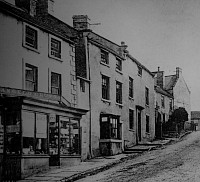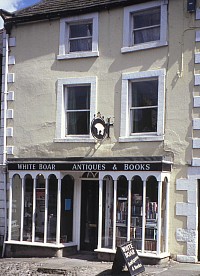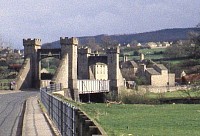More Tales of Middleham folk
This is on Sundial House. J B was John Briggs dial maker, and the date should read 1798 as he was not born until 1770 and died in 1853. The house was lived in by one branch of Tophams who were Tallow Chandlers, several generations of Harrisons, then Digbys who were drapers.
Leonard Digby was born here circa 1769, but he was not baptised until he was fourteen in 1783. He was a linen and woollen draper. He was also a Methodist Class Leader and a trustee for various chapels, and registered at the Quarter Sessions in 1812 as a Dissenting Preacher. He left his property to his sister, Ann Collinson. This house has also been the home of Barker, who was a Registrar of Births, Marriages and Deaths, and then a Post Office before becoming a private residence.
This is on Kirkgate and the shop on the left belonged to Angelo James Croft, plumber and glazier and Methodist Local Preacher. He was born in 1833, married a member of my family, Mary Gill of Birdridding in the parish of Coverham, and died in 1895. His wife Mary was a milliner and draper. He was from a family of plumbers and glaziers, his father James Croft, had been of that trade and he had brothers, cousins and nephews who were all plumbers, glazier or painters in many parts of the Yorkshire Dales.
This is what Angelo's shop looked like in the 1980s and 90s but the shop window has now gone and it is just an ordinary house. Middleham had many trades people and shopkeepers.
There had been tanners and saddlers, shoemakers and tailors; in fact you would need to go no further for all your needs. There had been tan pits on Kirkgate and in the 18th century the Langdale family and then the Dixon family had been tanners, then from 1820 to the 1870s Christopher Theakstone was a tanner.
Middleham was a prosperous place, with mercers and masons, tallow chanders and cabinet makers. There were professional men, who would have servants, attorneys, clergymen, doctors, school teachers and even Excise Officers. Amongst the attorneys was James Lindsey who witnessed many wills in the early 1700s,then the names Yarker and later Breare were prominent as men who acted as lawyers and agents for local estates , and investors in local mines. Later the name of Topham became the most prominent name, starting with Christopher Topham who was a lawyer, followed by his son Lupton Topham.
Wills reveal so much. This is the beginning of the will of Margaret Metcalfe of Middleham, spinster. She made a will in 1842 and her three witnesses were shopkeepers in the town : Robert Johnson, draper, John William Smith, druggist and John Nelson, draper. Some of the beneficiaries were the Cumby family, the children of her late sister Jane Cumby. Which makes a link with the will of Margaret Smith, spinster of Middleham dated 1821, who was very rich and very generous, and also made the Cumby family beneficiaries, mentioning Ann Cumby wife of Captain Cumby, who had been a Metcalfe. This was Captain William Pryce Cumby who had married Anne Metcalfe in 1801, and who commanded the Bellerophon at Trafalgar.
The Dixon family can be traced back to a Barbara Timms, a daughter of Matcham Timms, a jockey in the 18th century. Barbara married William Dixon, mercer of Middleham and had 13 children. Her sons John and William both went to London and made a fortune. John returned to Middleham, William died in Blackheath in Kent, but much of his fortune was bequeathed back to his relations in the dales. Their sister Elizabeth, or Betty, married one of the lawyers in the town, Francis Buckle, and she left her comfortable estate to her three daughters, one of whom, Jenny Sewell, then bequeathed her house to the Methodist Chapel to be used as a Manse.
Before a bridge was built over the River Ure there had been a boatman to take passengers across, or if on horseback it was forded. Alice Thornton, born Wandesford, described how she nearly lost her life crossing the River Ure at Middleham in 1644. She had gone to Middleham Castle where her sister had given birth to a son, and returning to Hipswell she crossed the River, incorrectly calling it "The Swaile", but said that there were stoops set up as guides by the Causey, but the river proved deeper than she expected and her mare "drew up her forefeet and I perceived she did swim". Alice clung on to the mare's neck and prayed.
When the river was in flood travellers had to take the road over Middleham Moor and then descend Gale Bank to Wensley. But in 1829 a suspension bridge was built, designed by Joseph Aloysius Hansom. However it lasted only a short time and fell into the river when a herd of bullocks was driven over it the following year. It was repaired and then replaced in 1865, no longer a suspension bridge the original towers remain.
Thomas Shields was probably the last boatman to take passengers across the river, and he died in 1833.
Newspapers give a particular slant on events, and I do wonder about this which was in the Northern Star 7th July 1838
On Sunday last in the parish Church, Middleham by the Reverend W Templeton, vicar, Mr Christian to Miss Bywell, both of the former place. The bridegroom is a widower of about five months, approaching fifty years of age. During his continuance in the single state, perfectly satisfied with his first matrimonial connexion, he has been particularly wishful to form a second; and his exertions for the last three weeks have been particularly strenuous and remarkably successful.
Mr Christian had previously been married to Jane and had been a grocer and draper when he baptised eight children. Jane was buried on the 12th December 1837 by which time he was the Receiver of the Tolls at the Suspension Bridge. He remarried on the 1st July 1838 and his new wife had produced a son who was baptised on the 28th April 1839. She produced three more, during which time John Christian became Innkeeper at the Suspension Bridge and then by 1844, a gardener




